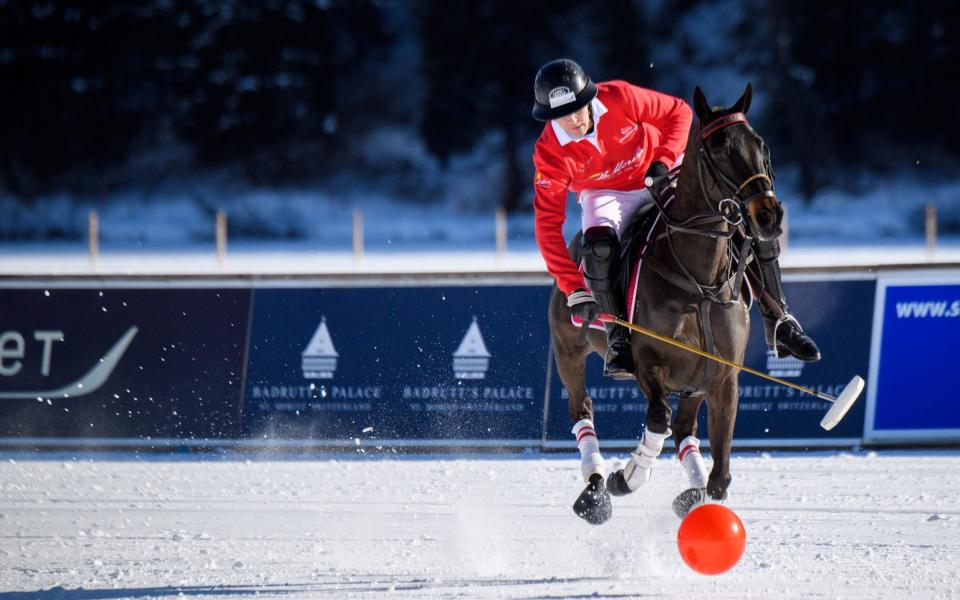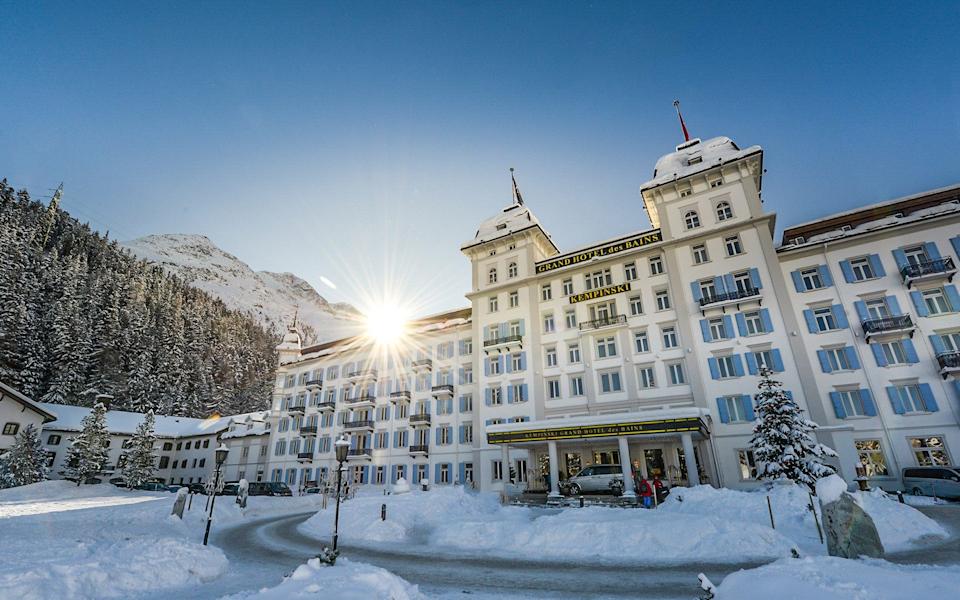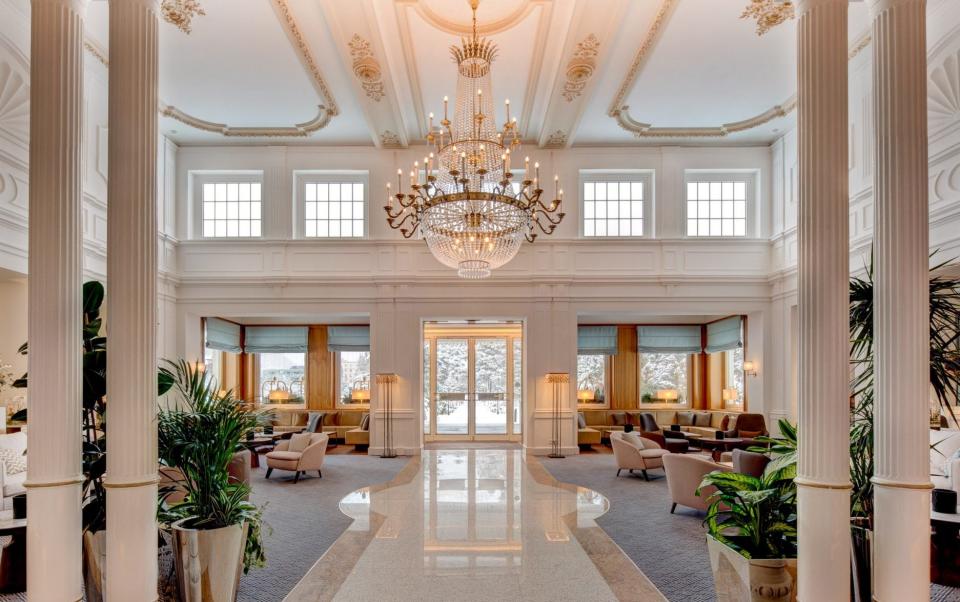The Swiss polo tournament for the super-rich – where the energy crisis doesn't seem to exist

“To become a millionaire in snow polo, you have to be a billionaire first,” Katja Grauwiler said as we entered the VIP viewing area of the 2023 Snow Polo World Cup in St Moritz. In the sloping stands, well-heeled – or should I say well-furred – guests quaffed glasses of Perrier Jouet as they politely cheered on teams playing against a backdrop of snow-capped mountains.
The tournament is the most exclusive event on Europe’s annual ski calendar, in part due to the luxurious experience on offer to guests, but also its elevated location on a frozen lake in the chic Swiss ski resort of St Moritz, 1,800m above sea level. The Engadin Valley resort invented snow polo in 1985 and revives the sport every year on the last weekend of January, attracting some 25,000 spectators.
I was there on the tournament’s first day to find out how such an event survives when, elsewhere in Europe, ski resorts are cutting lift capacity and turning off heating amid an ongoing energy crisis.

One of a kind
It was a cool -9°C in the midday “heat”, not that the designer-clad guests seemed to notice as they milled around the side lines or reclined on seats covered with luxurious navy throws. When the game was in play, a soft murmur of chatter was broken only by the occasional boom of a G6 private jet flying overhead, and we were close enough to the action to hear the mostly British accents of players encouraging each other – or apologising for missing a shot.
Between matches, the 750 guests retired to the heated VIP tent (costing CHF 350 (£307) to CHF 750 (£658) per person depending on the day), where caviar was served on a choice of Bellini or potato and oysters were shucked on beds of ice. An international buffet spread, catered by the famed Badrutt’s Palace, tempted diners in the main hall while in the lounge, various sponsors offered coffee, chocolate, alcohol, and cigars to jovial guests.

While this isn’t the world’s only snow polo competition, it’s the “most important” due to the large size of the field, said Grauwiler, a keen player and CEO at PR/ticular. “There are others in Kitzbühel, Cortina and Aspen but they’re played on smaller fields with three against three. In St Moritz, it’s four against four, like in normal polo.”
The three-day tournament costs organisers an average of CHF 2.5 million (£2.2 million) to host, with additional costs footed by the six teams, each of which bring at least 16 horses (four per player) to the valley. Many horses are from Argentina, “because they’re the best horses in the world,” said Grauwiler. “It’s a huge cost to the team owner, but if you win the tournament, you win honour.”
Heat wave woes
For the people of St Moritz, the event is a vital part of the ski season calendar. Organisers estimate that the three-day tournament brings in upwards of CHF 20 million (£17.7 m) in revenue for the Swiss economy.
This year, it was hit and miss whether the event would happen due to the unseasonably hot weather, which meant the lake didn’t freeze as early, or as deep, as usual. “We need to build this construction on 30cm of ice,” said Grauwiler. “A local company measures the exact depth using sticks and drones, and you’re not allowed to even start building if the ice is under 24cm.”
Usually, the lake freezes “around Christmas”, but this year, it remained too delicate until January 18 when construction teams got the all-clear, just nine days before the tournament began. “It was finished this morning at 10am,” she added. “You could say it’s due to global warming, but it has happened in the past.”
The ‘ugly truth’
Despite battling a warmer winter, organisers admitted to feeling little impact of increased costs due to the ongoing crisis in Europe. At the first-class venues and hotels that service the tournament’s guests business is booming.
One such establishment is the five-star Grand Hotel des Bains Kempinski St Moritz. The grand ski-in/ski-out hotel features a newly refurbished lobby with an Art Deco bar offering cocktails and whiskies up to CHF 720 (£630) per glass, and restaurants including the former two-Michelin star Cà d'Oro and an Italian so opulent it serves caviar on top of pasta.
There’s also a large spa with multiple saunas, a heated pool, and a cryotherapy chamber cooled to -116°C that’s frequented by Olympians and guests looking to shake jet lag in three minutes. Walking the hallways, it’s true, the crisis is far from peoples’ minds.

“It’s really business as usual for all the hotels like ours,” said Norman Zweyer, marketing manager at the hotel, which is running at 90 per cent capacity despite raising its prices. “All the costs have increased because of energy costs but I think for the clientele coming here, it’s like pocket money. It doesn’t matter if they pay CHF 100 or 200 more per night.”
“The ugly truth is that St Moritz was fully booked since the beginning of December, and it will be fully booked more or less until end of February. And the prices are rack rates (the highest rates) but people pay it,” Grauwiler added.
This sentiment is to be true across the resort. Designer stores, such as Prada, Dolce & Gabbana, Cartier and Chopard, appeared to be far more bustling than on London’s Bond Street. Louis Vuitton even had its own pop-up tent on the snow with a busy al fresco bar.

Visitors didn’t skimp on transport costs, either, Grauwiler said as a Gulfstream G650 flew overhead towards the Engadin Airport. “I’ve heard that the terminal is fully booked. Jets can fly in, but they have to fly out to Zurich or Milan and stay there because there is no space left for the whole weekend.”
Many of these guests fly from elsewhere in Switzerland and key markets including Germany and Italy, plus newer territories including South America and Southeast Asia. The war in Ukraine seems to have had little impact on visitor count. “The fact is, we never had more than 10 per cent Russians staying here in St Moritz,” Grauwiler says. “It was already decreasing before Covid and the war.”
As the sun set and guests filtered out the stands to continue their evenings at the resort’s well-heated restaurants, it seemed that St Moritz is a bubble of its own – its expensive price tag coming with the reassurance of a break from the issues facing many back home.
“Especially since Covid, people want to spend and spoil themselves and where can you do that better than here? You have great ski mountains, you have events, you have perfect hotels, and everything is exclusive,” said Zweyer. “It’s a unique place.” That it certainly is.
How to do it: Rachel was hosted by the Grand Hotel des Bains Kempinski St Moritz, where double rooms start from CHF 550 (£482) per night in the summer season and from CHF 750 (£657) per night in the winter season, inclusive of breakfast and tax. Visit kempinski.com. For more information on the St Moritz Snow Polo World Cup and for tickets, visit snowpolo-stmoritz.com.

 Yahoo News
Yahoo News 